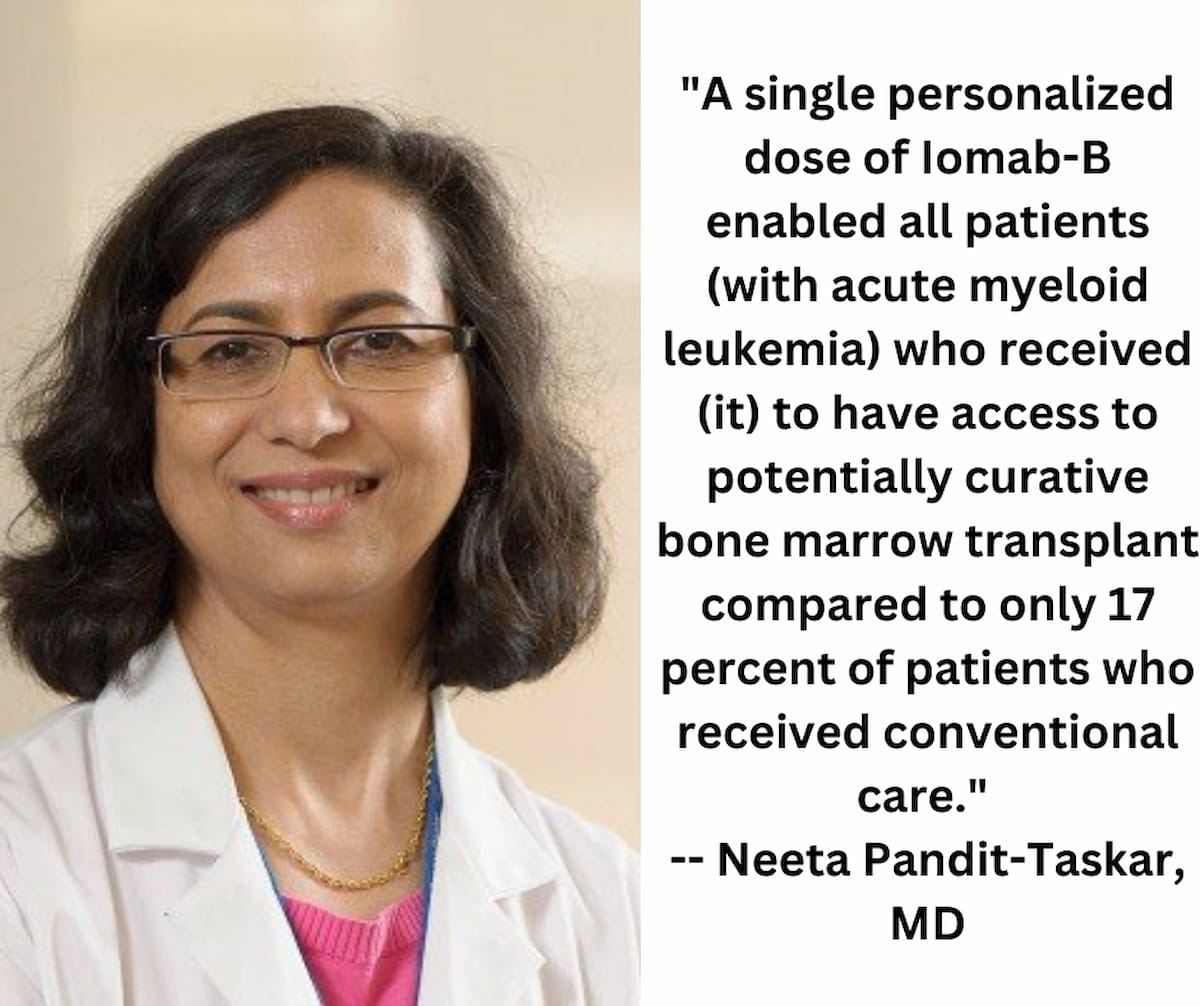Molecularly Targeted Radiation Agent Facilitates Bone Marrow Transplant in Acute Myeloid Leukemia
The research, which garnered “Abstract of the Year” honors at the Society of Nuclear Medicine and Molecular Imaging (SNMMI) conference in Chicago, demonstrates the potential of the targeted agent to significantly improve survival rates in AML.
More than 20,000 people will be diagnosed with acute myeloid leukemia (AML) in 2023, according to estimates from the American Cancer Society. However, new findings from a multicenter, phase 3 trial suggest that a high-dose, molecularly targeted radiation treatment may allow life-saving bone marrow transplants, contributing to durable complete remission (dCR) at six months in greater than 60 percent of patients with relapsed or refractory AML.
For the study, which received “Abstract of the Year” honors at the Society of Nuclear Medicine and Molecular Imaging (SNMMI) Annual Meeting in Chicago, researchers examined the use of Iomab-B (131-I apamistamab) and subsequent allogeneic hematopoietic cell transplant (HCT) in patients with relapsed or refractory AML. According to the study authors, Iomab-B facilitates myeloablation and eradication of leukemic cells via high-dose, molecular-targeted radiation of hematopoietic cells.
The researchers found that all 66 patients who received Iomab-B underwent HCT in comparison to 14 patients (18.2 percent) who received conventional care in the form of high-dose chemotherapy. Twenty-two percent of the Iomab-B cohort achieved dCR at six months and none of the patients in the conventional care group achieved this primary endpoint. Forty-four patients in the conventional care arm of the study crossed over to the Iomab-B treatment group and 40 of the patients subsequently had HCT, according to the study.
For additional content from SNMMI 2023, click here.
Emerging Molecularly Targeted Radiation Agent Facilitates Bone Marrow Transplant in Patients with Acute Myeloid Leukemia

In comparison to patients who did not crossover to the Iomab-B arm of the study, those who were treated with Iomab-B had double the survival rate at one year, according to the study authors. The researchers also noted long-term survival of two years or greater in 60 percent of patients who had dCR after treatment with Iomab-B.
“This pivotal study showed that a single personalized dose of Iomab-B enabled all patients who received the therapeutic dose to have access to potentially curative bone marrow transplant compared to only 17 percent of patients who received conventional care. Iomab-B also demonstrated long-term survival benefit for patients who met the primary endpoint, and safety of the Iomab-B led regimen was excellent,” noted lead study author Neeta Pandit-Taskar, M.D., the clinical director of radioimmunotherapy and theranostics at the Ludwig Center for Cancer Immunotherapy at the Memorial Sloan Kettering Cancer Center in New York, New York.
In regard to the safety profile, Pandit-Taskar and colleagues also noted over a 22 percent lower rate of sepsis for patients treated with Iomab-B and HCT (6.1 percent) in comparison to the conventional care cohort (28.6 percent). They also found that Iomab-B had lower rates of febrile neutropenia (43.9 percent versus 50 percent) and mucositis (15.2 percent versus 21.4 percent) in contrast to conventional care.
What New Research Reveals About Novice Use of AI-Guided Cardiac Ultrasound
April 4th 2025In a study recently presented at the American College of Cardiology (ACC) conference, researchers found that novice use of AI-guided cardiac ultrasound after an AI-enabled electrocardiogram increased the positive predictive value for reduced left ventricular ejection fraction (LVEF) or aortic valve stenosis by 33 percent.
GE HealthCare Debuts AI-Powered Cardiac CT Device at ACC Conference
April 1st 2025Featuring enhanced low-dose image quality with motion-free images, the Revolution Vibe CT system reportedly facilitates improved diagnostic clarity for patients with conditions ranging from in-stent restenosis to atrial fibrillation.
New AI-Enabled Portable Ultrasound May Facilitate 50 Percent Reduction in Cardiac Imaging Scan Time
March 28th 2025Artificial intelligence (AI)-powered measurement capabilities provide key features with the Compact Ultrasound 5500CV device, which was unveiled at the American College of Cardiology (ACC) conference.
GE HealthCare Launches PET MPI Agent Flyrcado at ACC Conference
March 28th 2025The positron emission tomography myocardial perfusion imaging (PET MPI) agent, which offers a significantly higher half-life than other cardiac PET agents, was recently granted pass-through payment status by CMS that will go into effect on April 1, 2025.
New Collaboration Offers Promise of Automating Prior Authorizations in Radiology with AI
March 26th 2025In addition to a variety of tools to promote radiology workflow efficiencies, the integration of the Gravity AI tools into the PowerServer RIS platform may reduce time-consuming prior authorizations to minutes for completion.